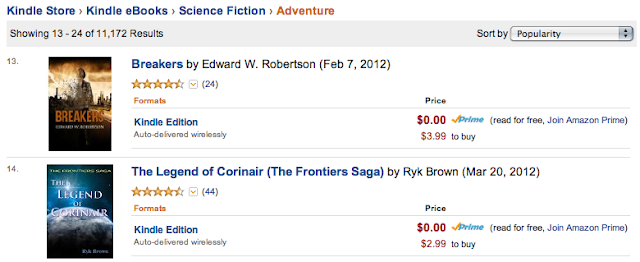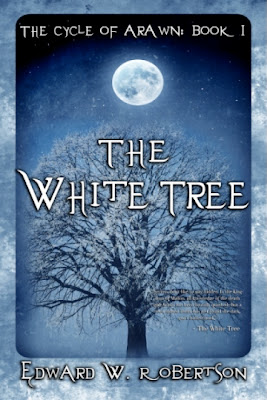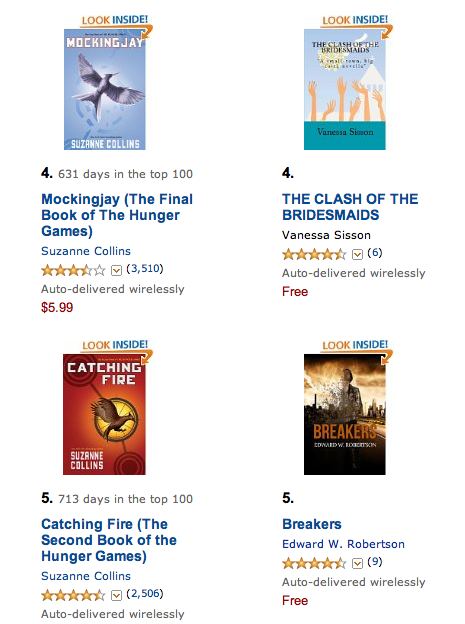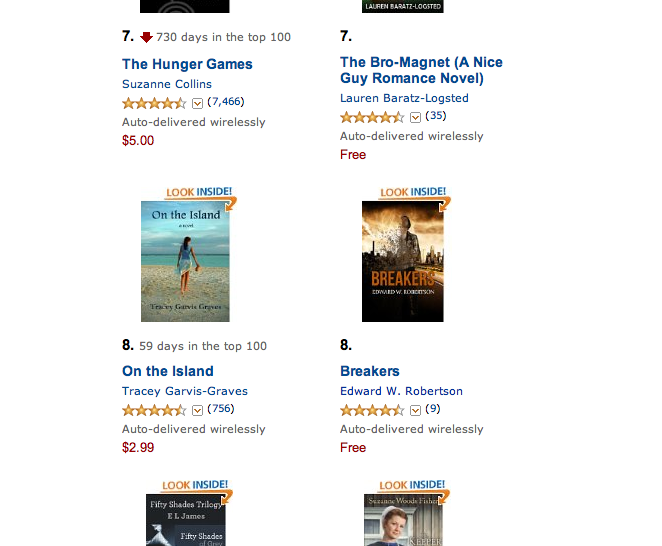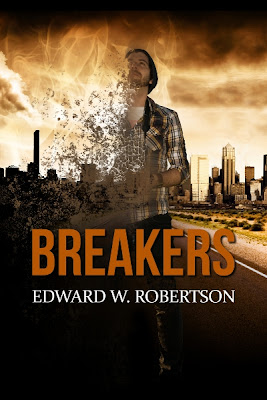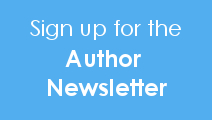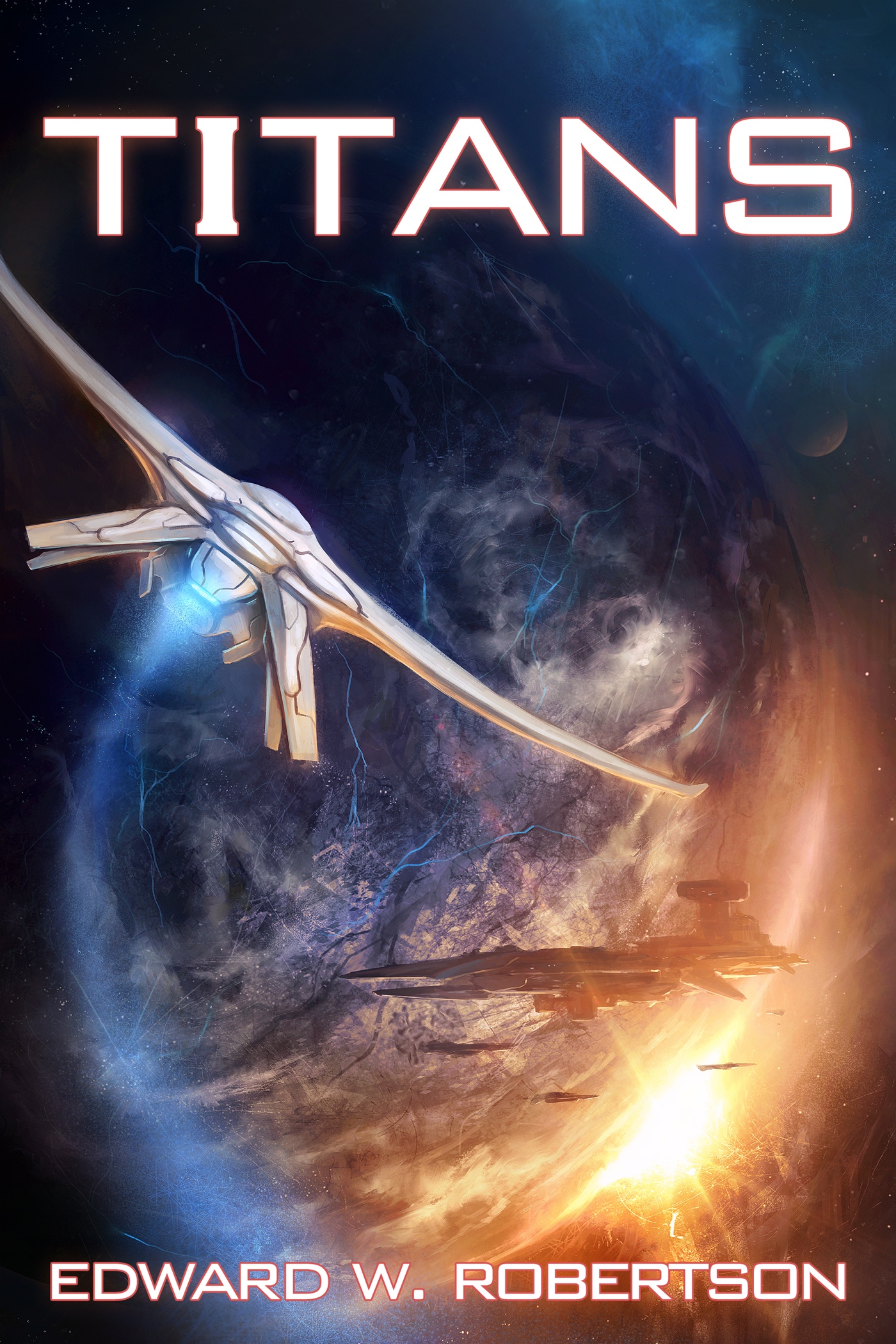So we’re now three weeks into Amazon’s most recent set of algorithms. I don’t know the first thing about what they’ve meant for the overall activity of the Kindle store, but in terms of books in the Select program and free giveaways, some trends are starting to emerge. And they generally aren’t too favorable.
Yet they aren’t completely disastrous, either (depending on your definition of “disaster,” anyway). Phoenix Sullivan has a week’s worth of data on ten different titles showing a 500% increase in income in the week after her most recent free runs. At the same time, she sees that it now takes a significantly higher number of downloads to see increased sales.
Over at the Kindleboards MEGA-THREAD devoted to the tracking of free data, results are kind of all over the map, but show persistent evidence of decreased post-free sales. (Link goes to results posted after the May 3 changes; when browsing, make sure to look for free runs that took place after that date.) Still, it’s also showing that post-free sales haven’t dried up completely. Meanwhile, Russell Blake, who’s been doing pretty well for himself in part due to free runs and is touch with a bunch of other authors, has mentioned post-free sales are only about 10% of what they used to be back in the glory days. In the episode of the Self-Publishing Podcast I was on, Johnny B. Truant mentioned he’d recently given away 8000 copies and seen no appreciable sales bump. After what Phoenix has termed the Golden and Silver Ages of Select, these diminished numbers are fairly discouraging.
But here’s something else that appears to be a part of the new system:
This is Breakers‘ entire sales history, dating back to its release on February 7. Now let me doctor the charts a little bit:
The two red bars mark the approximate dates of algorithm changes. 0, 1, 2 all fell during the days of List A; 3 took place during the days of List A/B/C; 4 is what we’re seeing with the most recent set. 0 was the release date. 1, 2, and 4 came after free runs. 3 was an ad/sale price promo.
The pattern’s pretty clear, right? Under the old algorithms, books would peak, then gradually decline over the next few days until they returned to Spiky Land, where sales are few and inconsistent. (My Spiky Land sales rate was generally 0-6 per day.) The trajectory looked like the flight of a lofty home run ball in reverse–a swift rise, then a steady downward slope. Since my latest free run under the new algorithms, however, the sales trajectory is more like.. the path of a torpedo. A sexy torpedo. One that doesn’t show any major signs of slowing down.
For another three weeks, anyway, which is when things will get really interesting. What’s happening here is this. Breakers gave away 2.5 shitloads of books on its last free run (where a “shitload” is defined as 10,000 copies–note that we’re using customary measurements, not the Imperial scale). Right before it was free, its popularity list rankings were #121 in Thrillers > Technothrillers and worse than #500 in Science Fiction > Adventure. Where is it now?
Technothriller isn’t the biggest category in the Kindle store, but SF > Adventure is a pretty tough one. This is the category where George R.R. Martin and Wool chew everyone else up and drool them down their sales-fattened bellies. Yesterday, Breakers was actually #12–page 1!–but a new release from Amazon’s 47North imprint vaulted ahead of it today.
Here’s the difference between the old algos (List A) and the new. When Breakers came off free, it would have vaulted to #1 in both categories. It probably had enough downloads that it would have hit page 1 of the entire Mystery & Thrillers genre. This would have produced a rush of sales (almost certainly hundreds), but after a few days, its rank would start to decay. It would get leapfrogged by the latest post-free books off big runs of their own. Within about a week–maybe two, given a giveaway of this magnitude–it would probably be back down near its former rank and sales.
If anything, the opposite is true now for big giveaways. Initially, Breakers hit Technothrillers at #12 and Adventure at #27. It hadn’t sold much over the 30 days prior to being free. 110ish copies, I think. The new pop lists look at a 30-day rolling window of sales. Once it reverted to paid, then, its pop list placement was calculated based on 25K freebies + 110 sales. But since its free run, it’s been selling 70+ copies per day. As the 30-day window advances, then, last month’s low sales days are discarded from the equation while its most recent high sales days are added to it. The result: it has steadily climbed the pop lists ever since.
By now, it’s probably about peaked. And in another 3 weeks, those 25K freebies will roll beyond the window. At that point, it will drop down the pop lists again. How much? That will be determined entirely through how many copies it sold over its new 30-day window. But if that arrow-straight sales line from its sales history holds out, we’d be talking somewhere in the neighborhood of 1500-2000 copies–in other words, enough that it’ll probably still be somewhere on page 1 of Technothrillers, and probably page 3 of SF > Adventure. That would still be a lot of pop list visibility.
In other other words, it could get sticky.
Assuming the algos don’t change over that time, of course. And that I don’t get 50 consecutive one-star reviews. And that the collective unconsciousness doesn’t decide Breakers is 300-some pages of garbage and that its author should be defenestrated with all possible haste. Or that interest doesn’t simply dry up. The U.S.S. Me could be torpedoed at any time.
Back to the big picture. In general, Select is no longer as effective at generating sales as it was just last month. The visibility produced by most giveaways is much lesser than it was before. But if you get lucky enough, that visibility will last for much longer. More visibility, more sales. While in most cases, Select is the least useful it’s ever been–and part of me isn’t happy about that at all–in certain instances, it’s become a more powerful tool than ever.
Yesterday, Taleist put out their survey of the self-publishing climate, Not a Gold Rush. The biggest news to come out of it is that self-publishing is no get-rich-quick scheme: last year, half of all self-published authors who responded to the survey made less than $500 a year. This was apparently so shocking it was worth mention in the Guardian.
My response? Yeah, no shit.
Having spent most of last year down in the ranks of #100,000 – 866,000 on Amazon, I can attest that there are a lot of people there. Like a literal million!
Let’s do some numbers. It currently takes about 1 sale/day to sustain a rank of #100,000. If you’re selling your book at $2.99 like a good old-fashioned indie, you’re making about $2 per sale. If your book sells 365 copies at $2 apiece, it’s pulling $730 per year. To sell slightly less than that, about 5 copies/week, your rank will hang out in the neighborhood of #150,000. In other words, some 850,000+ books–roughly 85% of Amazon’s listsings–potentially fall beneath that earnings threshold. (Obviously most are traditionally published works that retail for more than $2.99, but bear with me.)
If your rank’s around #500,000, you’re probably only selling about 1/month. In more other words, 50% of the books in the Kindle store are selling 20 or fewer copies per year.
Of course, we’re talking about individual books, which authors are known to produce more than one of. And I don’t know how many of the 850,000+ books that fall beneath that potential earnings threshold are self-published. But that should provide some picture of the scope we’re working with. There are a lot of books. There are a lot of authors. And most don’t sell very well at all.
And you know what? I don’t see how it’s a knock on self-publishing that half of the authors reported in the survey (which covered 1,007 participants) are making $500/year or less. Selling books is hard! It’s amazing that half are making more than $500 a year!
Then again, they probably aren’t, because the survey was self-selecting. Rather than being a truly random sampling of authors, those surveyed opted in, volunteering their information. Almost inevitably, this will skew results towards the most successful side of the environment–people who are doing well be more enthusiastic about sharing news of their success. The more successful writers are the ones most likely to be active on the forums etc. where Taleist culled their data. They’ve caught a lot of flak on this front for a small and unrepresentative sample size.
I’m inclined to be more forgiving. 1,007 authors is actually a pretty big sample. If it were random, the results would be pretty reliable. Even assuming there’s a built-in bias towards the successful side of the scale, we’re looking at results that are probably somewhere in the ballpark of accurate. Same league, anyway. Then again, the Rangers are in the same league as the Twins. That is a baseball joke.
Rather, my main issue with Not a Gold Rush is that most of its stats are correlative.
For instance, they report that “authors who get help (paid or unpaid) with story editing, copy editing, proofreading, and cover design make 34% more than the average.” But what does that mean? That’s not proof that getting help causes success. Instead, outside help correlates with–is somehow related to–success in selling books. But is that because a proofread book will generally sell more books? Or because those authors who are already successful are the ones most likely to be willing and able to hire a proofreader?
Some of these correlations don’t pass the smell test, either. According to their data, authors who tried and failed to acquire agents and traditional book contracts sell worse than those who never tried the traditional route at all. That doesn’t sound at all right to me. That’s the kind of counterintuitive stat that would have me suggesting that perhaps this survey skewed towards the proudest indies out there.
To be fair, the survey purportedly doesn’t present the data in terms of “Doing X causes a YY% increase in earnings.” But we should not rush to draw those conclusions for ourselves, either. You can see how the meaning of these stats is already getting fuzzy–“Judging by this survey of authors who are disproportionately successful to the rest of the self-publishing world, those who did this, that, and the other thing are somehow related, in ways we can’t prove, to a modest increase in royalties.”
So is the data (and the book it’s sold within) worthless? No. At the very least, it is, as others have said, an interesting historical snapshot of where the self-publishing world was at (or nearby) at the time the survey was taken. It will be particularly interesting to compare it to next year’s results, which they’re already planning to collect, and the next several years after that. Furthermore, although much of the data isn’t hard evidence of a cause and effect relationship between the choices you make as an author and the impact of those choices on your sales, it is slight evidence that doing this or that could help give your sales a boost. (I was shocked to learn that only 41% of those polled paid artists to design their covers. Either there are a lot of multi-talented authors out there, or people need to start cracking their wallets!)
Overall, however, I’d treat it with caution. The numbers might not mean what they appear to mean. They’re pretty fuzzy. Interesting, but far from conclusive. Take anything in the book with a grain of salt. Oh, and you should probably treat my perspective on it just as skeptically. After all, it’s not like I read the damn thing.
I’ve been interviewed over at the Self-Publishing Podcast today. The topic is, naturally enough, Amazon’s algorithms past and present and what they currently mean for indie authors, particularly those in Select. The guys asked some really great questions. On top of me rambling about numbers, we got into several discussions about possible strategies to start looking into in light of these new changes, including the importance of categories, pricing, how to best manage your free runs, etc.
Oh, they’re pretty funny, too. I had a great time with it. And according to themselves–always the most reliable source!–they’re the #1 iTunes podcast on self-publishing. I can see why. Go have a listen.
Earlier this month, I predicted unhappily that the recent changes to Amazon’s algorithms would mean Select authors would see fewer sales after making their books temporarily free.
Last week, I made Breakers free anyway.
I don’t really remember what I was expecting out of this run. I think I was hoping to get between 2000-6000 downloads, to sell a few dozen extra copies in the week after, and to get some personal experience with Amazon’s new system. Instead, I gave away nearly 26,000 copies of my book.
I’m going to pause for a second to say that if this makes me sound like some sort of expert at giving away books, I’m not. This was a happy confluence of circumstance. I hadn’t given away many copies of Breakers before and had only been mentioned by any of the major sites once, back in early March and late in the afternoon. When I went free this time, all the major sites listed me. And the book was almost completely fresh to their entire readership. If you want to try to duplicate that, go ahead, but trust me, “do mediocrely for three months in preparation for a gamble on a single massive free run” wasn’t exactly my strategy.
Anyway. So I thought the recent changes would be bad for free runs (and most reports indicate people are seeing a steep decline in post-free sales), but I had a suspicion that if you gave away enough copies–“enough” meaning “enough to land high on the popularity lists despite your giveaway copies being steeply discounted by the formula”–you might be able to do well anyway. And since the new lists count for 30 days instead of 3-4, if you could do well, there’s a chance you’ll do very well.
A day and a half after my free run ended, here’s Breakers:
That’s based on 173 sales and 93 borrows over that span.
I feel like I might have just buried the lede. Lead? Whatever, it’s early. Anyway, what does this mean long-term? I don’t know. I’m trying not to know just yet, because I don’t want to get my hopes up. But prior to this free run, Breakers was #121 on the Technothrillers popularity list and worse than #500 on Science Fiction > Adventure. On day three of its run, it improved to #10 Technothriller and #27 Sci-Fi > Adventure. Right now, it’s #8 and #24. I’m guessing sales will slow down after an initial rush, but hold, driven by the pop lists, at a decent clip, for an unknown length of time. If that happens, I will be a very happy Ed.
Other results: three new very nice reviews, a 5-star and two 4-stars. Also, I learned borrows report almost immediately. Possibly because borrows are completely internal to Amazon and they don’t require any payment processing. So if you have a run like this, when you revert to paid, you’re going to see a wonky ratio of incoming borrows : sales until sales reports start catching up.
I’m going to try to force the goo between my ears to not analyze this any further for the next week. By then, the trend should be more clear. Right now, I’m just going to be happy.
Since going free has been less effective lately (although…), I’m trying out some other strategies to see what happens. So right now, The White Tree is just $0.99 on Amazon (formerly $3.99). I plan to leave it there until Tuesday, 5/22, but I reserve the right to change that plan at any time. It’s my book! I do what I want!
Ahem. In brief, The White Tree is an epic fantasy novel about two young men dragged into a shadowy war and their attempts to hold onto their morality in the face of escalating chaos, violence, and lies. It’s about 150,000 words long–somewhere around 450-600 pages, depending on how you calculate things. I’m currently writing the last chapter of the sequel, The Great Rift, which will be somewhere around 180-200,000 words, depending on what I do with my revisions. In other words: big fat fantasy epics!
Anyway, buy it. Or don’t buy it. I’ll never know. But, you know. Right now, it’s kind of a bargain.
Here’s the cover:
Snazzy, right? Well what are you waiting for?!
Yesterday afternoon, after a lot of discussion and deliberation, I decided to make Breakers free on Amazon for another day. Today, here’s what I woke up to:
At the time, though, I wasn’t at all sure it would be the right decision. As of around 5 PM PST, I was crossing 17,000 downloads. I’d been in the Top 10 all day.
(cont. in a minute, just want to get this picture online real quick…)
So Breakers has now spent a full day free on Amazon. How’s it doing? Well, take a look:
#8 in what, you say? Well, that would be the entire free store.
I don’t know what happens next. If you’d like to help me stick there–or take a run at greater heights–please spread the news.
That’s right. The newly becovered Breakers is free on Amazon today. Please download and enjoy.
It’s not yet noon, and it’s already been downloaded 1200 times. In the time it’s taken me to type this sentence, it’s been downloaded another 6 times. Seriously. As of the end of this sentence (which took me a little longer to fix typos), it’s had 24 more downloads. What is the root of this madness?
It’s definitely not me. It’s thanks to sites that watch and mention free ebooks. Every single one is valuable, but I’d like to single out three of the largest for special mention.
The first is Michael Gallagher’s Free Kindle Books and Tips. Michael is very personable and accessible. Lately, he’s been running a series of posts on Kindleboards to help authors get their books listed on the free book sites. The first is on making sure your book has a strong description. The second is on the importance of covers. Both have a lot of sound advice from someone who runs one of the most prominent free and bargain book blogs out there. I highly recommend giving them a look.
The second site I’d like to mention is Ereader News Today. This site is extremely prominent. If you’re listed there, you can count on a successful day. I haven’t had any direct conversations with its frontman Greg, but from everything I hear, he, like Michael, is very friendly and helpful. I’ve seen him drop in on KB a few times. Whenever he does, you can be sure he’s made some author’s day. ENT offers a really diverse selection of books, too.
Lastly, Pixel of Ink. I don’t quite know what to tell you about Pixel of Ink. They’re very mysterious! And also extremely influential in getting your book in front of readers. Like the other sites, the best way to get listed with them is to have a great cover, a strong description, and equally strong reviews. If you can get mentioned by them, it will make a world of difference. I’m kind of in love with them. So, hey, POI. Are you, uh.. seeing anyone?
There are many other free book sites out there (Freebooksy, for one, looks like it’s positioned to become a success), all of which I’d recommend keeping on your radar whether you’re a reader or a writer. They’re almost uniformly run by great people who love books.
I will return with the numbers and the analyzin’ as new results come in. Oh, and in the 15 minutes it’s taken me to put this together? Over 250 more downloads.
Wow. Thanks, everyone.
I’ve made a small edit to my first post on Amazon’s recent changes to their sales algorithms. As you’ll recall, in that post, I took a look at the three different sets of popularity lists Amazon was displaying between March 19 and May 3. To summarize, List A was Select- and indie author-friendly. List B showed signs that making your book free would be drastically less effective than it used to be. And List C looked downright draconian: even strongly-selling indie books that had never been free were ranked 15-25% worse on List C than on List B.
Originally, we thought this was because List C factored physical book copies into its ranks, inadvertently penalizing indies who predominantly sell ebooks. We were wrong. The difference appears to be about price.
I first started looking into this after Phoenix Sullivan noticed there were very few $0.99 books high on the popularity lists. (The popularity lists are the main browsable lists displayed on Amazon. For instance, the Epic Fantasy list can be seen here.) It was theorized that the new algorithms were discriminating against the $0.99 price setting, weighing $0.99 sales at a lesser value than at higher price points. I wasn’t entirely comfortable with this theory, because I generally don’t think Amazon sets their algorithms with specific goals in mind (besides “Make $, win”). So I compared hundreds of books on several different popularity lists, focusing on the lowest-priced ebook titles. Soon, I was honing in on the highest-priced books, too. Because I was seeing something very, very strange.
The higher the price, the better the book was placed on the popularity lists.
In other words, say you’ve got a $0.99 book at #10 on the Epic Fantasy list. (Popularity list, not bestseller.) Say its sales rank (bestseller list) is #1000. The books at #9 and #11, meanwhile, are both listed at $9.99–and their sales ranks will probably look more like #3000, say.
This isn’t an ironclad correlation. Bestseller rank is a transitory thing. It shifts very quickly compared to popularity rank; a book that’s #1000 today could be #1 or #10,000 tomorrow. Seeing one instance of a book outperforming its bestseller rank on the pop list ranks proves nothing.
Seeing hundreds of these instances, however, is another thing altogether.
And that’s what I saw. Repeatedly. Undeniably. It was 1 AM, I’d had a couple of drinks, and my fiancee was snoring on the couch as I nerded it up with my numbers, but what I was seeing was strong enough to not only prove the theory I’d set out to disprove, but to go one step further: all things being even in terms of sales, not only did a lower price indicate a worse position on the popularity lists, but a higher price indicated a better one.
The implications for indie authors are immediate. And not pleasant. Most indie authors price their ebooks between $0.99 – $5.99. A few brave souls and small presses price as high as $9.99, but generally speaking, $5 and under is seen as the way to reach readers who may be hesitant to take a shot on a lesser-known or completely anonymous author. But if you price at $2.99 while HarperCollins prices at $12.99, you’re going to have to sell significantly more copies to be neighbors on the popularity lists. And if you’re selling at $0.99, you’re going to have to sell very, very well to achieve the same level of visibility.
We’ve termed this change “price biasing.” Here’s what it looks like in practice. Let me show you a shot of the Epic Fantasy popularity list:
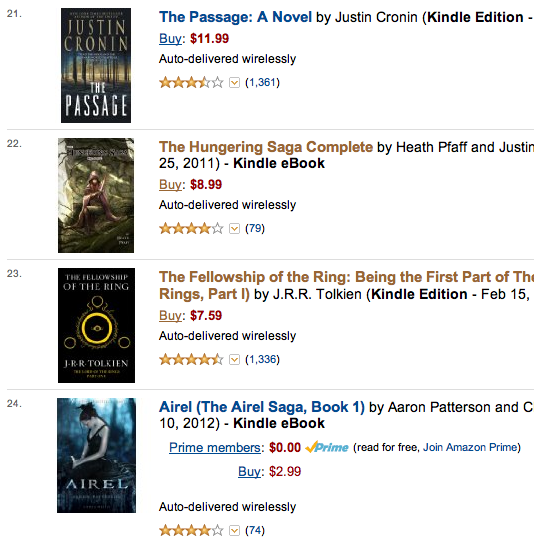 |
| Evidence of price biasing: Epic Fantasy popularity list, page 2 |
Now, here is the bestseller rank of these same titles:
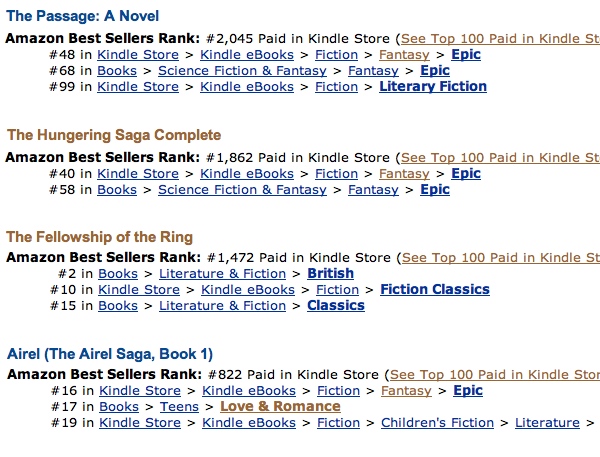 |
| Bestseller ranks of these same books |
Let’s move to the next page:
 |
| Epic Fantasy popularity list, page 3 |
And their bestseller ranks:
 |
| Bestseller ranks of these same books |
Take a look at that–in the first example, all of the higher-priced books shown are ranked above the lower-priced books on the popularity list, but their sales ranks are worse. In order! In the second example, the $0.99 book requires drastically higher sales to keep pace on the popularity lists with the $13.99 book. For another example of price biasing, simply go to the top of Epic Fantasy, where George R.R. Martin’s A Game of Thrones 4-Book Bundle, is priced at $29.99 with a bestseller rank of #60 and a popularity list rank of #1. The next book, Martin’s A Game of Thrones, is priced at $8.99, yet is #2–behind the omnibus–despite a bestseller rank of #27.
There are a lot of variables at play here. Because of the volatility of bestseller rank, I can’t be certain that the higher-priced books haven’t outsold the lower-priced ones over the last 30 days, and it will be easy enough to find counter-evidence where books are “properly” ranked and price seems to make no difference. But I’ve tried to minimize the variables by choosing books that haven’t been recently released (so sales should be steadier) and by going to page 2 and 3 of the popularity list, where the volatility should be lesser than at the very top. Really, it wasn’t hard to find this example. Because it’s all over the place. And if you look at hundreds and hundreds of titles next to each other on the popularity lists–especially the extremes, $0.99 – $2.99 books next to $12.99 – $29.99 books–the correlation is extremely high.
I don’t have the answers to a lot of the inevitable questions. I don’t know what the “ideal price” would be to take advantage of this new formula. I don’t know how many more copies you need to sell at $0.99 to achieve the same weight as you would selling at $9.99. I don’t know why Amazon did this, particularly when they price their own imprints at $7.99 and under. I don’t know if this is the end of the world or a brief couple weeks of suffering followed by another golden age.
And let’s not storm the gates or raise all our titles to $199.99 just yet. The popularity lists are far from the only driver of sales through Amazon. There are bestseller lists. Targeted emails. Bargain book lists of all shapes and sizes which you’ll only make through pricing lower. And if you raise your prices significantly enough to achieve a major change on the new popularity lists, you may drive away so many sales your placement actually winds up going down. Unless you’re priced at $0.99, I don’t think raising your price by a dollar or two will make any real difference to your placement on the popularity lists, so please don’t overreact–if you’re still selling, you’re still selling, no matter how the new algorithms may work.
Still, I don’t see how these new lists are any good for indies under any circumstances. What they do is force us to sell more books to maintain the same visibility as higher-priced trad titles. They diminish our ability to experiment with lower prices, whether the goal is a temporary sale, a low-priced entrypoint to a series, or because you just don’t feel comfortable charging more than $0.99 for that 5000-word story.
Furthermore, the playing field is no longer level. Indie authors published through KDP only earn 70% royalties at prices between $2.99 and $9.99. Yet many traditionally published books that are most benefiting from price biasing are priced at $12.99 – $14.99, with some omnibus editions priced as high as $22.99 – $29.99. If indies want to match those prices to match their visibility on the popularity lists, they’ll actually make less money with each sale than they would at $9.99. There’s no way to win.
I don’t like fearmongering. But I don’t see how it helps to sit on this information any longer. I encourage you to look at the popularity lists for yourself. Maybe I’m wrong. I’d prefer if I were. I’ll try to answer any questions in comments, but be prepared for a lot of “I don’t know.” All I know for sure is that if this analysis is correct, the deck has been stacked against us. I highly doubt it was intentional. Indies aren’t being targeted. We’re just a small part of the Amazon equation, and as Amazon attempts to maximize their revenues, I really don’t think they care who that revenue’s coming from. And remember: this is just one factor among many, many others as to how a book is seen on Amazon’s storefront. It’s not a revolution in and of itself.
But it does feel like it will have some impact on indie authors. I thought it was time to share and let everyone experiment for themselves.
A couple weeks ago, I started talking to an artist about a new cover for Breakers. A couple days ago, she finalized my new cover:



